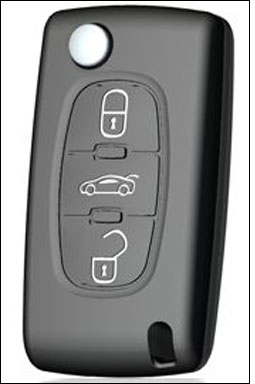Cell phones used to be just for making phone calls, and car keys were only for unlocking doors and trunks, as well as starting engines. Now, smart phones function as handheld computers, and vehicle keys act as personal assistants, automatically unlocking doors and starting engines as a driver nears and enters his or her car. And soon, thanks to the Near Field Communication (NFC) Gateway Key Fob, developed by Delphi, an automotive technology provider based in Troy, Mich., drivers will be able to use NFC-enabled phones to do everything from checking tire pressure and mileage, to receiving maintenance alerts, to tracking down their car’s location—all without leaving home, work, a café or wherever they happen to be.
The key fob contains a passive RFID tag that will enable a driver to exchange information between his or her car and Web-enabled phone. Delphi hopes that automakers will begin offering the technology with new car models in Asian, European and U.S. markets as soon as 2013, says Jermone Coudre, the new product manager for Delphi’s electronics and safety department. To use the key fob, a driver would need to own an NFC-enabled phone and download and install an application onto the handset, explains Craig Tieman, a development manager with Delphi’s advanced concepts and market division.
NFC technology supports high-frequency (HF) 13.56 MHz RFID tags and readers that comply with the ISO 14443 (both Type A and Type B) and FeliCa air-interface protocols. NFC-compatible RFID tags are being embedded in cards by transit agencies and retailers to pay for goods and services (see ORCA Puts Ferries, Buses and Trains on One Ticket and Coffee Republic Brews Up RFID Loyalty Cards). But the technology is also available in a number of phones sold in Asia and Europe. In the United States, adoption has been slower, though an NFC peripheral attachment is available for the iPhone, while phones based on the Google Android platform are expected to be available by the end of 2010. Other options include the installation of an RFID module that plugs into a mobile phone’s microSD memory card slot, thereby enabling a cell phone to function as an NFC passive RFID tag and interrogator (see MicroSD Card Brings NFC to Phones for Credit Card Companies, Banks).
With the NFC Gateway Key Fob, automakers would integrate an NFC reader module into their vehicle designs and drivers would then use the key fob to upload or download data to the car’s NFC module, which will be linked to the vehicle’s main computer system where data such as mileage and tire pressure, customized seat configurations or climate control settings, are stored. The car’s computer would also forward any required maintenance reminders or alerts regarding low fluid levels to the fob, which would then pass them along to the user’s phone. By synching this information between the fob and the car’s reader module, the system enables the driver to access these car settings remotely, as long as he or she has both the key fob and the cell phone at hand.
“No matter where you are, you can interact with your phone application and download information to the car [the next time you get inside],” Tieman states. “You can make changes to the car’s interior temperature settings, or configure a new playlist from inside a restaurant, for example.” Once you get into your car, the fob will transfer this data to the vehicle’s controls and automatically make the adjustments.
For electric vehicles, this technology could be especially helpful, as it would allow a driver to know his or her car’s most recent battery level, even if that individual were not inside the vehicle.
Although Delphi’s key fob will employ RFID to enable communication between a user’s car and phone, many automobiles utilize some type of RFID-enabled key fob for other purposes. With one type of fob, the driver must press a button on the device to activate a battery-powered ultrahigh-frequency (UHF) tag embedded in that fob, which communicates with an RFID reader inside the car and triggers the vehicle’s doors to unlock or lock—or, in some models, switches on the ignition system. A newer type of key fob, based on low-frequency (LF) RFID technology, does not require the driver to press any buttons—he or she can leave the fob in his or her pocket, and as soon as that person is within the reader’s range, the device will trigger the door to unlock or the engine to start. Delphi’s NFC tag could be built into either of the main two types of key fobs, Tieman explains, and would operate separately from the fob’s car-access or ignition functionality.
“We’re really just riding the trend in smart phones,” Tieman says. As phones continue to adopt wireless standards, such as NFC and Bluetooth, Delphi wants to be able to leverage the new technology applications this provides to drivers. In fact, the company has also developed a version of the Gateway fob that utilizes Bluetooth technology to port vehicle data between a driver’s phone and car.
Technology already exists enabling a driver to use a cell phone to access his or her vehicle’s usage settings or location, through services such as OnStar. However, Tieman notes, these services are based on service subscriptions. The Gateway Fob technology, he says, would not require the driver to pay ongoing fees for the service.


